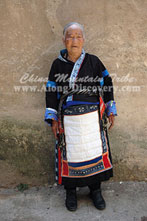 |
SW China/Guizhou Textiles & Festival Travel Guide |
| Tin Weaving | ||||
|
Tin weaving is a Miao embroidery technique. This stitch is used by
the Miao and popular in Raohao, Nanzhai, Jiupang, Mantianxin, Gaoqiu
of Jianhe county. The embroidered patterns are in the Chinese words
of 嵐 or 勉, it is usually used on back or front aprons, I've seen one
nice jacket all made of tin weaving in Jiupang village. My last trip
to Raohao village was in March 2010 with 5 Americans, before my visit,
the last visitors are two Japanese who visited the village in 2003,
because the road is so bad, many tourists had to give up going this
region to see this special embroidery technique.
The whole process of
tin weaving is done as the following(reference from One Needle,
One Thread): |
||||
|
For more information about this stitch, I highly recommend the book-One Needle written by Tomoko Torimaru, so far, this is the best book for Guizhou embroidery stitches, Tomoko Torimaru and her mother are the best field experts for Guizhou ethnic textiles. This embroidery technique takes so much time and labor to finish, even a small piece of front or back apron, and now the labor price in the countryside is not cheap, so the price in the village is high now. For instance, it's about 500RMB for a front apron, sometimes it's much more expensive than some textile shops in Kaili or Beijing, because those vendors had collected the textiles some 20 or 30 years ago by paying maybe just 5-50 RMB for each and stored them to wait for a better price, so now they can sell them about 120-300RMB for each in the shops. |
||||
|
When I talked to some villagers in Raohao village, why I can't see people wear jackets made of tin weaving, they said it took so much time, now the young don't want to stay in the village, most of them like to go out to big cities to make money, so no one likes to continue this embroidery technique. |
||||
|
 |




